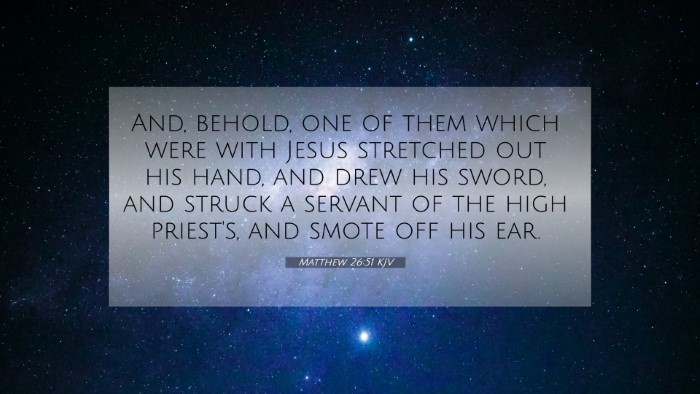Bible Verse Meaning and Interpretation: Matthew 26:51
Matthew 26:51 states: "And, behold, one of them which were with Jesus stretched out his hand, and drew his sword, and struck a servant of the high priest, and smote off his ear."
Summary of Matthew 26:51
This verse occurs during the arrest of Jesus in the Garden of Gethsemane. The action taken by one of Jesus' followers reflects a desperate effort to defend His master. The event introduces themes of violence, betrayal, and the fulfillment of prophecy.
Commentary Insights
-
Matthew Henry:
Henry highlights the impulsiveness of Peter, who drew his sword in an attempt to protect Jesus. This act of aggression, though zealous, was misguided and ultimately counters the peaceful teachings of Christ.
-
Albert Barnes:
Barnes notes the identity of the assailant as Peter, linking this moment to the overall theme of human weakness in the face of divine purpose. He emphasizes that while the disciples meant well, their actions were inappropriate for the kingdom Jesus came to establish.
-
Adam Clarke:
Clarke further analyzes the significance of the servant's injury, indicating that it symbolizes the violence present even in moments of spiritual crisis. He also discusses the prophecy being fulfilled through Christ's arrest and the ensuing events.
Thematic Connections
Matthew 26:51 opens discussions surrounding the nature of discipleship, courage, and the role of violence in religious contexts. This verse connects strongly with several broader Biblical themes, including:
- The call to non-violence: Christ's message consistently advocates for peace over violence.
- Betrayal and loyalty: The moment is tinged with the betrayal atmosphere, as Judas has already made a deal to hand over Jesus.
Cross-References
For a deeper understanding of Matthew 26:51, consider the following cross-references:
- Luke 22:49-51 - Another account of the incident with emphasis on Jesus' response.
- John 18:10 - Identifies Peter as the disciple who drew the sword.
- Matthew 5:39 - Jesus' teaching on turning the other cheek, contrasting Peter's action.
- Isaiah 53:5 - The prophecy of the suffering servant, highlighting Jesus' forthcoming suffering.
- Psalms 22:16-18 - A messianic prophecy that foreshadows the events surrounding Christ's crucifixion.
- Zachariah 13:7 - References to the striking of the shepherd, alluding to the arrest of Jesus.
- 1 Peter 2:21-23 - Peter's later teachings on Christ’s example of suffering without retaliation.
Understanding Matthew 26:51 in Context
This verse does not exist in isolation; it serves as a key part of a greater narrative. Understanding the connections between Bible verses enriches the comprehension of the scripture as a whole. Here’s how this verse connects with other key passages:
- Exploring the dynamics in Matthew 26:47-56, where the arrest unfolds, illustrates the culmination of Jesus' ministry and the disciples' response.
- John 18:11 offers a contrast where Jesus seeks peace and healing despite Peter’s aggression.
- Matthew 26:54 where Jesus explains that if He wanted to, He could call for legions of angels, again emphasizing His purpose of peace and sacrifice.
- Insights from Luke 22:35-38 show the preparation for a hostile environment, where Jesus prophesied the need for swords in a metaphorical sense.
- Links to the discussions in Matthew 16:23 reveal Peter’s struggle to understand the nature of Jesus’ mission.
Conclusion
Matthew 26:51 serves as a poignant lesson in the complexities of human emotion, loyalty, and the teachings of Jesus. As the events unfold toward the crucifixion, this verse embodies the struggle between divine purpose and human action. By engaging in comparative Bible verse analysis and establishing thematic Bible verse connections, readers can appreciate the depth of scripture and its cohesive narrative.
Tools for Bible cross-referencing such as a Bible concordance or a cross-reference Bible study guide can greatly enhance study and understanding of verses like Matthew 26:51. By learning how to find cross-references in the Bible, believers can identify connections that enrich their faith and comprehension of God’s word.










